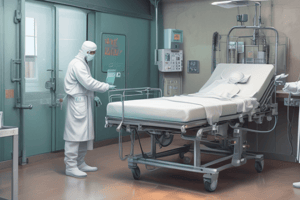Podcast
Questions and Answers
What is the main difference between sterilization and disinfection?
What is the main difference between sterilization and disinfection?
- Sterilization is only achieved through physical methods, while disinfection is only achieved through chemical methods
- Sterilization is used for living tissue and skin, while disinfection is used for inanimate objects
- Sterilization requires shorter exposure times compared to disinfection
- Sterilization eliminates all forms of microbial life, while disinfection eliminates many or all pathogenic microorganisms, except bacterial spores (correct)
Which method is described as the most important method of sterilization in medical practice?
Which method is described as the most important method of sterilization in medical practice?
- Radiation
- Heat (correct)
- Filtration
- Chemical sterilants
Why are disinfectants not used for skin antisepsis?
Why are disinfectants not used for skin antisepsis?
- Because they can injure skin and other tissues (correct)
- Because they are not effective against microorganisms on skin
- Because they have a strong odor that is not suitable for skin application
- Because they can only eliminate bacterial spores
What do terms with the suffix 'cide' or 'cidal' indicate?
What do terms with the suffix 'cide' or 'cidal' indicate?
What are antiseptics and disinfectants used for?
What are antiseptics and disinfectants used for?
Which of the following best describes sterilization?
Which of the following best describes sterilization?
What distinguishes antiseptics from disinfectants?
What distinguishes antiseptics from disinfectants?
What is the main difference between sterilization and disinfection?
What is the main difference between sterilization and disinfection?
What do terms with the suffix 'cide' or 'cidal' indicate?
What do terms with the suffix 'cide' or 'cidal' indicate?
What are chemical sterilants?
What are chemical sterilants?
Flashcards
Sterilization
Sterilization
Destroys ALL microbial life forms.
Disinfection
Disinfection
Eliminates many/all pathogens, NOT spores.
Most important sterilization method
Most important sterilization method
Heat
Why not use disinfectants on skin?
Why not use disinfectants on skin?
Signup and view all the flashcards
'-cide' or '-cidal' suffix meaning
'-cide' or '-cidal' suffix meaning
Signup and view all the flashcards
Antiseptics
Antiseptics
Signup and view all the flashcards
Disinfectants
Disinfectants
Signup and view all the flashcards
Sterilization definition
Sterilization definition
Signup and view all the flashcards
'-cide' suffix indicates...
'-cide' suffix indicates...
Signup and view all the flashcards
Chemical sterilants
Chemical sterilants
Signup and view all the flashcards
Study Notes
Sterilization and Disinfection
- Sterilization eliminates all microorganisms, including spores, whereas disinfection eliminates most microorganisms, but not necessarily all spores.
- Autoclaving is described as the most important method of sterilization in medical practice.
Antiseptics and Disinfectants
- Antiseptics are used for skin antisepsis, while disinfectants are not, due to their toxic effects on skin.
- Antiseptics and disinfectants are used to control the growth of microorganisms on skin and surfaces.
Terminology
- Terms with the suffix 'cide' or 'cidal' (e.g., bactericide, virucidal) indicate the ability to kill microorganisms.
- Chemical sterilants are chemicals used to sterilize surfaces and equipment.
Key Concepts
- Sterilization is a process that completely eliminates all microorganisms, including spores, from a surface or equipment.
- The main difference between sterilization and disinfection lies in their scope of microorganism elimination, with sterilization being more comprehensive.
- Antiseptics are distinguished from disinfectants by their safe use on skin, whereas disinfectants are typically used on surfaces.
Studying That Suits You
Use AI to generate personalized quizzes and flashcards to suit your learning preferences.




